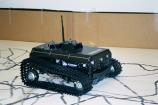

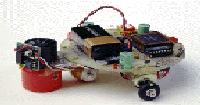
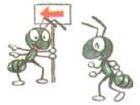
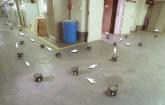
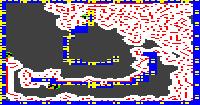
Tutorial on Ant Robotics






Abstract
Ants are fascinating social insects. They are only capable of short-range interactions, yet communities of ants are able to solve complex problems efficiently and reliably. Ants have therefore become a source of algorithmic ideas for distributed systems where a robot (or a computer) is the ``individual'' and a swarm of robots (or the network) plays the role of the ``colony.'' This half-day tutorial gives an overview of the state of the art in ant robotics, an area of artificial intelligence that uses ants as inspiration. Ant robots are simple and cheap robots with limited sensing and computational capabilities. This makes it feasible to deploy teams of ant robots and take advantage of the resulting fault tolerance and parallelism. Ant robots cannot use conventional planning methods due to their limited sensing and computational capabilities. Rather, their behavior is driven by local interactions. For example, ant robots can use trails to follow other ant robots or cover terrain robustly, similar to ants that lay and follow pheromone trails. Ant robotics is a rapidly growing area in both artificial intelligence and robotics. In the past couple of years, researchers have developed ant robot hardware and software and demonstrated, both in simulation and on physical robots, that single ant robots or teams of ant robots solve robot-navigation tasks robustly. Researchers have also developed a theoretical foundation for ant robots, based on ideas from real-time heuristic search, stochastic analysis, and graph theory.
This tutorial on the current state of the art in ant robotics is given by experts who will give an overview of this exciting area without assuming any prior knowledge on the topic. It will cover all important aspects of ant robotics, from theoretical foundations to videos of implemented systems. To this end, it will bring together the various research directions for the first time, including theoretical foundations, ant robot hardware, and ant robot software. Its primary objective is to give non-specialists a comprehensive overview of the state of the art of the field, for example, to allow researchers and students to do research in the area and to allow practitioners to evaluate the current state of the art in ant robotics. Consequently, it is of interest to anyone who is interested in multi-agent systems, distributed problem solving, search, mobile robotics, and artificial intelligence in general.
Speakers
The material for the tutorial has been provided by the five researchers listed below, all of which are experts on the topic of ant robotics. They have been selected to cover the theory of ant robotics as well as practical approaches, including ant robot software and hardware.
Sven Koenig (Georgia Institute of Technology, USA)
 Sven Koenig became an assistant professor in the College of Computing
at Georgia Institute of Technology after receiving his Ph.D. in
computer science from Carnegie Mellon University. He is the recipient
of an NSF CAREER award, an IBM Faculty Partnership Award, the Raytheon
Faculty Fellowship Award from Georgia Tech, and a Fulbright Fellowship
Award. He is currently on the editorial board of the Journal of
Artificial Intelligence Research (JAIR) and will co-chair the
International Conference on Automated Planning and Scheduling (ICAPS)
in 2004. Sven's research centers around techniques for decision making
(planning and learning) that enable situated agents to act
intelligently in their environments and exhibit goal-directed behavior
in real-time, even if they have only incomplete knowledge of their
environment, limited or noisy perception, imperfect abilities to
manipulate it, or insufficient reasoning speed. He has published over
60 papers on this topic in the artificial intelligence and robotics
literature.
Sven Koenig became an assistant professor in the College of Computing
at Georgia Institute of Technology after receiving his Ph.D. in
computer science from Carnegie Mellon University. He is the recipient
of an NSF CAREER award, an IBM Faculty Partnership Award, the Raytheon
Faculty Fellowship Award from Georgia Tech, and a Fulbright Fellowship
Award. He is currently on the editorial board of the Journal of
Artificial Intelligence Research (JAIR) and will co-chair the
International Conference on Automated Planning and Scheduling (ICAPS)
in 2004. Sven's research centers around techniques for decision making
(planning and learning) that enable situated agents to act
intelligently in their environments and exhibit goal-directed behavior
in real-time, even if they have only incomplete knowledge of their
environment, limited or noisy perception, imperfect abilities to
manipulate it, or insufficient reasoning speed. He has published over
60 papers on this topic in the artificial intelligence and robotics
literature.
Israel Wagner (Technion and IBM Haifa Research Lab, Israel)
 Israel Wagner received his B.Sc. degree in computer engineering from
the Technion (Israel Institute of Technology), Haifa, in 1987, cum
laude, an M.Sc. degree in computer science from Hebrew University,
Jerusalem, in 1990, cum laude, and a Ph.D. degree in computer science
from the Technion in 1999. He was a research engineer at General
Microwave, Jerusalem, from 1987 until 1990, when he joined the IBM
Haifa Laboratories as a member of the technical staff. Israel is
currently an adjunct senior lecturer in the Computer Science
Department at the Technion. His research interests include
multi-agent robotics, manual and automatic VLSI design, computational
geometry, and graph theory. He has published over 25 papers on these
topics in the artificial intelligence, robotics, and VLSI literature
and co-edited a special issue of the Annals of Mathematics and
Artificial Intelligence on ant robotics in 2001.
Israel Wagner received his B.Sc. degree in computer engineering from
the Technion (Israel Institute of Technology), Haifa, in 1987, cum
laude, an M.Sc. degree in computer science from Hebrew University,
Jerusalem, in 1990, cum laude, and a Ph.D. degree in computer science
from the Technion in 1999. He was a research engineer at General
Microwave, Jerusalem, from 1987 until 1990, when he joined the IBM
Haifa Laboratories as a member of the technical staff. Israel is
currently an adjunct senior lecturer in the Computer Science
Department at the Technion. His research interests include
multi-agent robotics, manual and automatic VLSI design, computational
geometry, and graph theory. He has published over 25 papers on these
topics in the artificial intelligence, robotics, and VLSI literature
and co-edited a special issue of the Annals of Mathematics and
Artificial Intelligence on ant robotics in 2001.
Andrew Russell (Monash University, Australia)
 Andrew (Andy) Russell received his B. Eng. and Ph.D. degrees in 1972 and
1976, respectively, from the University of Liverpool, in the U.K. After
a brief period in the computer industry he took a position as Engineer
working on robot design and applications in the Department of Artificial
Intelligence at the University of Edinburgh, Scotland. For the past 19
years he has been a member of academic staff at the University of
Wollongong and now at Monash University (both in Australia). Andy's
research interests include robot tactile sensing, the design of robotic
mechanisms and olfactory sensing for robots. He has written books on
robot tactile sensing and odour sensing for mobile robots and published
over 70 refereed conference papers and journal articles describing his
work in intelligent robotics.
Andrew (Andy) Russell received his B. Eng. and Ph.D. degrees in 1972 and
1976, respectively, from the University of Liverpool, in the U.K. After
a brief period in the computer industry he took a position as Engineer
working on robot design and applications in the Department of Artificial
Intelligence at the University of Edinburgh, Scotland. For the past 19
years he has been a member of academic staff at the University of
Wollongong and now at Monash University (both in Australia). Andy's
research interests include robot tactile sensing, the design of robotic
mechanisms and olfactory sensing for robots. He has written books on
robot tactile sensing and odour sensing for mobile robots and published
over 70 refereed conference papers and journal articles describing his
work in intelligent robotics.
Richard Vaughan (HRL Laboratories, USA)
 Richard Vaughan received a D.Phil. in Computation from Oxford
University in 1999, and a B.A. (Hons.) in Computing with Artificial
Intelligence from Sussex University in 1993. He was a postdoctoral
research associate at the Robotics Laboratory of the University of
Southern California from 1998 to 2001, and is currently a member of
the technical staff at HRL Laboratories. Richard's research concerns
the mechanisms of intelligent behavior in individuals and groups of
people, animals, robots and software agents. His projects emphasize
dynamic autonomy, scalability, interaction and simplicity. The
majority of his more than 20 publications concern the functional
analysis and recreation of aspects of animal behavior, a methodology
he calls "constructive ethology". His other papers are on simulation,
interfacing and networking for robotics applications. Richard is a
founding member of the Player/Stage project, which creates tools for
robotics and sensor network research.
Richard Vaughan received a D.Phil. in Computation from Oxford
University in 1999, and a B.A. (Hons.) in Computing with Artificial
Intelligence from Sussex University in 1993. He was a postdoctoral
research associate at the Robotics Laboratory of the University of
Southern California from 1998 to 2001, and is currently a member of
the technical staff at HRL Laboratories. Richard's research concerns
the mechanisms of intelligent behavior in individuals and groups of
people, animals, robots and software agents. His projects emphasize
dynamic autonomy, scalability, interaction and simplicity. The
majority of his more than 20 publications concern the functional
analysis and recreation of aspects of animal behavior, a methodology
he calls "constructive ethology". His other papers are on simulation,
interfacing and networking for robotics applications. Richard is a
founding member of the Player/Stage project, which creates tools for
robotics and sensor network research.
David Payton (HRL Laboratories, USA)
 David Payton is principal research scientist and manager of the
Cooperative and Distributed Systems Department at HRL Laboratories in
Malibu, California. He received his B.S. degree from UCLA in 1979 and
his M.S. degree from MIT in 1981. David is currently principal
investigator for the DARPA Pheromone Robotics project and is also
involved in development of agent-assisted multi-user collaboration
tools. After joining HRL Laboratories in 1982, David has been involved
in numerous projects for the development of intelligent autonomous
agents. This includes work on the DARPA Autonomous Land Vehicle
project, the Unmanned Ground Vehicle and the development of
behavior-based robot control. David has over 25 publications in the
area and holds six patents.
David Payton is principal research scientist and manager of the
Cooperative and Distributed Systems Department at HRL Laboratories in
Malibu, California. He received his B.S. degree from UCLA in 1979 and
his M.S. degree from MIT in 1981. David is currently principal
investigator for the DARPA Pheromone Robotics project and is also
involved in development of agent-assisted multi-user collaboration
tools. After joining HRL Laboratories in 1982, David has been involved
in numerous projects for the development of intelligent autonomous
agents. This includes work on the DARPA Autonomous Land Vehicle
project, the Unmanned Ground Vehicle and the development of
behavior-based robot control. David has over 25 publications in the
area and holds six patents.
Tutorial Material
Here are some slides:
Additional Information
Here are pointers to additional material:
For questions or requests of additional information, please send email to Sven Koenig (skoenig@usc.edu).
The text of this particular webpage (but not its figures) is available for modification and reuse under the terms of the Creative Commons Attribution-Sharealike 3.0 Unported License and the GNU Free Documentation License (unversioned, with no invariant sections, front-cover texts, or back-cover texts) as long as it is accompanied by a pointer or the URL of the original webpage, which is https://idm-lab.org/antrobotics-tutorial.html.